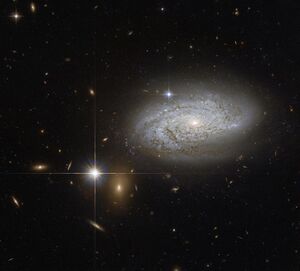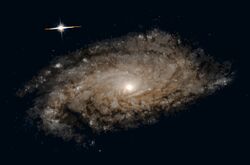Astronomy:NGC 3021
| NGC 3021 | |
|---|---|
 NGC 3021 (right of center) as seen by the HST | |
| Observation data (J2000 epoch) | |
| Constellation | Leo Minor[1] |
| Right ascension | 09h 50m 57.146s[2] |
| Declination | 33° 33′ 12.94″[2] |
| Redshift | 0.00514±0.000013[3] |
| Helio radial velocity | 1,537±4 km/s[4] |
| Galactocentric velocity | 1,502±4 km/s[4] |
| Distance | 92.8 Mly (28.44 Mpc)[4] |
| Apparent magnitude (V) | 10.88[3] |
| Apparent magnitude (B) | 12.54[4] |
| Absolute magnitude (V) | −21.25[3] |
| Characteristics | |
| Type | SA(rs)bc,[5] 4.0[4] |
| Apparent size (V) | 1.6′ × 0.9′[3] |
| Notable features | Starburst galaxy[5] |
| Other designations | |
| NGC 3021, UGC 5280, PGC 28357[6] | |
NGC 3021 is a spiral galaxy in the northern constellation of Leo Minor. It is about 93 million light-years away from Earth,[4] and is receding with a heliocentric radial velocity of 1,537±4 km/s.[4] This galaxy was discovered December 7, 1785 by Anglo-German astronomer William Herschel.[7] The morphological classification of NGC 3021 is SA(rs)bc,[5] which indicates a spiral galaxy with no central bar (SA), an incomplete inner ring structure (rs), and moderate to loosely wound spiral arms (bc).
The galaxy contains many Cepheid variable stars. These stars have been used to measure the distances of galaxies. This galaxy was also used to help refine the measurement of the Hubble constant.[8]
Supernova
On November 1, 1995, S. Pesci and P. Mazza in Milan, Italy reported the discovery of a supernova in the NGC 3021 galaxy. G. M. Hurst in England confirmed the finding, estimating the magnitude at 13.2. Designated SN 1995al, it was offset 15.0″ west and 2.9″ south of the galactic nucleus.[9] The spectrum matched a type Ia supernova and was found to be similar to SN 1981b near maximum.[10] On 18 February 2023, a second supernova appeared in this galaxy: SN 2023bvj (Type II, mag. 17).[11]
References
- ↑ Hille, Karl (July 30, 2015). "Hubble View of a Cosmological Measuring Tape". NASA. https://www.nasa.gov/content/goddard/hubble-view-of-a-cosmological-measuring-tape.
- ↑ 2.0 2.1 Brown, A. G. A. (August 2018). "Gaia Data Release 2: Summary of the contents and survey properties". Astronomy & Astrophysics 616: A1. doi:10.1051/0004-6361/201833051. Bibcode: 2018A&A...616A...1G. Gaia DR2 record for this source at VizieR.
- ↑ 3.0 3.1 3.2 3.3 "NASA/IPAC Extragalactic Database (NED)". California Institute of Technology. http://ned.ipac.caltech.edu/cgi-bin/objsearch?search_type=Obj_id&objid=21102.
- ↑ 4.0 4.1 4.2 4.3 4.4 4.5 4.6 Tully, R. Brent et al. (August 2016). "Cosmicflows-3". The Astronomical Journal 152 (2): 21. doi:10.3847/0004-6256/152/2/50. 50. Bibcode: 2016AJ....152...50T.
- ↑ 5.0 5.1 5.2 Anupama, G. C. (November 1997). "Optical Spectra of Recent Supernovae of Type Ia: SN1995AL, SN1997Y, SN1997BP". Astronomical Journal 114: 2054. doi:10.1086/118625. Bibcode: 1997AJ....114.2054A.
- ↑ "NGC 3021". SIMBAD. Centre de données astronomiques de Strasbourg. http://simbad.u-strasbg.fr/simbad/sim-basic?Ident=NGC+3021.
- ↑ Seligman, C.. "NGC Objects: NGC 3000 - 3049". Celestial Atlas. https://cseligman.com/text/atlas/ngc30.htm#3021.
- ↑ information@eso.org. "A cosmological measuring tape" (in en). https://www.spacetelescope.org/images/potw1513a/.
- ↑ Pesci, S. et al. (November 1995). Green, D. W. E.. ed. "Supernova 1995al in NGC 3021". IAU Circular 6255 (1): 1. Bibcode: 1995IAUC.6255....1P.
- ↑ Wei, J. -Y. et al. (November 1995). Green, D. W. E.. ed. "Supernova 1995al in NGC 3021". IAU Circular 6256 (1): 1. Bibcode: 1995IAUC.6256....1W.
- ↑ "SN 2023bvj | Transient Name Server". https://www.wis-tns.org/object/2023bvj.
External links
 |


